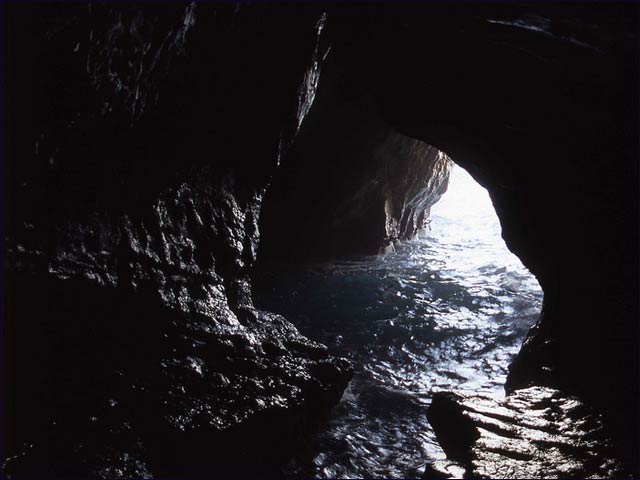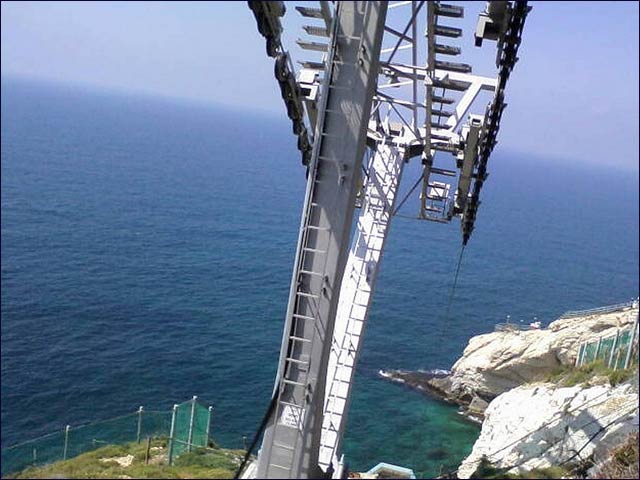By Avigayil Kadesh
As you descend by cable car 210 feet down the white cliff of Rosh Hanikra, it’s hard to know where to focus your gaze on the two-minute ride: The picture-perfect Mediterranean beach below? The sea promenade stretching south though Nahariya to Haifa? The nature reserve islands Techelet ("Sky Blue"), Shachaf ("Seagull") and Nachlieli ("Wagtail")?
Kissing the border of Lebanon, Rosh Hanikra (literally, Top of the Cavern) is one of northern Israel’s most beloved tourist destinations. A multisensory experience combines stunning views with the roar of waves rushing in and out of the caverns that the waters cut in the cliff over thousands of years.
Rosh Hanikra is the only mountain ridge in Israel that descends straight to the sea. It’s comprised of three layers -- hard limestone, soft chalk embedded with flint, and porous dolomite.
The isles of Rosh Hanikra, together with the isles of neighboring Tel Achziv National Park, sit atop the western Kurkur (Sandstone) Mountains of the Galilee coastal plain.
These little land masses formed through an abrasion process were sites for salt and shellfish dye industries in ancient times. Nesting birds, including the seagulls and wagtails they’re named after, still call these islands home. There is even a loggerhead sea turtle reserve at Rosh Hanikra.
Whatever you decide to focus on during the 60-degree-angle ride down, once you reach the bottom the main attraction is the natural limestone grottoes believed to have begun with a series of underground shocks that tore into the bedrock.
Over a long time, as rainwater and waves entered the fissures, they formed tunnels and sea caves -- otherwise known as grottoes.

Inside the grottoes of Rosh Hanikra.
Photo courtesy of the Israel Tourism Ministry
Legend of the bride, sound-and-light show
The Rosh Hanikra grottoes are open all year and even at night, when they’re lit up and especially dramatic. As you walk along the 656-foot walking track, you’ll see and hear the crashing waves and feel the warmth radiating from this explosive encounter. Fruit bats, rock pigeons, swallows and hyrax are all part of the landscape.
“The grottoes are the most fun when it’s stormy because the water comes crashing through the holes,” says Joe Yudin, CEO of Touring Israel. The spray can reach up 115 feet and crest over the edge of the cliff.
“When the weather is calm, it’s still very beautiful -- but either way, be careful to hold the handrails because it can be slippery,” he cautions.
When you’re listening to the indescribable sounds the water makes as it rushes in and out, think about the local legend of a young woman of nearby Acre (Akko) who was brought against her will to marry an old, wealthy man in Lebanon. While en route, the story goes, the maiden jumped from her horse into the sea, and her sad song can still be heard within the grottoes of Rosh Hanikra.
Another legend ascribes the origin of eyeglasses to a boy marooned at Rosh Hanikra with his mother, for whom he fashioned corrective lenses from the sand of the beach.
Though these stories are fanciful, another story of Rosh Hanikra is historical fact: the Night of the Bridges.
On the night of June 16, 1946, as part of the struggle for independence, the pre-state Palmach fighting force sent troops to blow up 11 bridges linking Israel to Lebanon, Syria, Jordan and Egypt. The men assigned to the two bridges at Rosh Hanikra were spotted by the British Army and shooting broke out – setting off the explosives and collapsing one target, the railroad bridge along the Cairo-to-Beirut line. A memorial was built to honor the 14 men who died in the operation.
Today, in the railroad tunnel dug by the British in 1943, you can watch a 15-minute sound-and-light show about how the tunnel was built and go on a virtual tour of the grottoes.

View from the cable carElephant Leg
As you walk between the grottoes, look out toward the sea to take a picture of Elephant Leg, a natural formation created in the cliff by the seawater in the shape of an elephant’s leg. On the cliff itself you can see fossilized starfish.
Back at the top, most visitors like to take a posed shot in front of the sign at the border crossing that shows you are standing 120 kilometers from Beirut and 200 kilometers from Jerusalem.
Then it’s time for a stroll along the beach promenade that follows the same route used by travelers in ancient times. Here you can see the remains of the Cairo-Beirut rail tracks. The promenade ends at a visitors’ center and souvenir shop. A snack bar and restaurant also are along the promenade.
Yudin recommends visiting Rosh Hanikra early in the morning to avoid long waits at the cable cars, due to the many school groups that come through later in the day. And he also suggests planning a whole day’s adventure by combining Rosh Hanikra with Acre.
“You can buy a combo ticket and get a nice discount,” he says. This ticket will admit you to Acre’s Knights Hall, Templer Tunnel and Akashi Museum as well as Rosh Hanikra and the cable car. Yudin usually includes a tour of the Baha'i Gardens in Acre, the lesser-known of the two landscaped marvels of northern Israel (the more famous one is in Haifa) administered by members of the Baha'i Faith and open to the public for free.